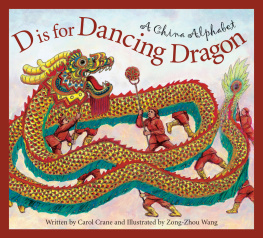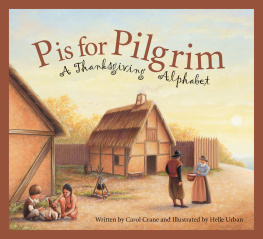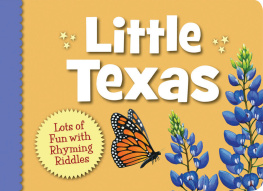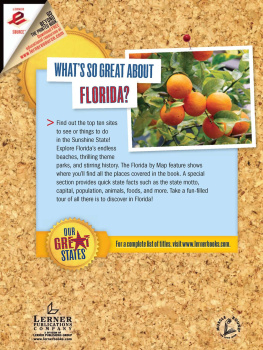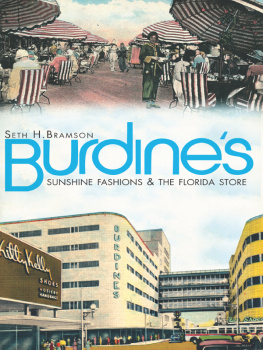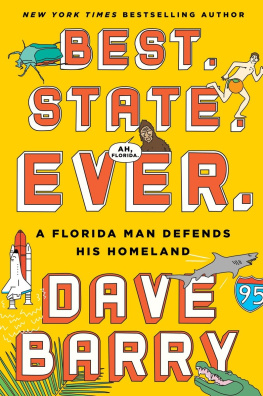S is for Sunshine
A Florida Alphabet
The magic of Florida comes to life in this playful book, with illustrations by Michael Monroe. Author and national education consultant Carol Crane brings together the flora and fauna, geography, and history of the Sunshine State with entertaining poems and fascinating facts. Test your knowledge of this colorful state and bring home a bit of sunshine with S is for Sunshine: A Florida Alphabet.
S is for Sunshine
A Florida Alphabet
Written by Carol Crane and Illustrated by Michael Glenn Monroe
For Conrad and our seven grandsons:
Brad, Bryan, Blair, Pat Jr., Paul,
Conner, and Casey...all readers.
Carol Crane
To my sister, Jane, also an artist, her husband,
Bruce, and my two nephews, Ryan and Joey.
Thanks for all of your support.
Michael Glenn Monroe
A
The alligator is our state reptile. This reptile has lots of teeth, but cannot chew. Teeth are used to grab food and then it is swallowed whole. A mother alligator lays 20-50 eggs into a nest, called a clutch. An alligator can stay underwater for more than an hour. On land, the alligator can only run in a straight line. It is the largest reptile in North America.
A is for Alligator, a slow submarine with eyes.
Brackish water, swamps, and rivers, on the banks he lies.

B
Beach sands are different colors in Florida. White sand is made of quartz. Tan sand is broken pieces of colored shells. Black sand, unusual for Florida, is caused by minerals.
Florida is a peninsula. A peninsula is land that is almost surrounded by water. The Atlantic Ocean is east of Florida. The Straits of Florida is to the south and east. The Gulf of Mexico lies to the west and to the south. The states of Alabama and Georgia are to the north.
B is for Beaches, 700 miles of shells and sand.
Tiny little crystals, sifting through my hand.

C
Florida is the largest cattle grazing state east of the Mississippi River.The subtropical climate grows grass for the cattle all year long. Cracker is another name for cowboy, who with the snap of his cracking whip, drives the cattle.
When the Spanish arrived in Florida, they brought with them the first Florida cattle. Cattle living in Florida have to be able to withstand subtropical heat and humidity. The Brahman, imported from India via Texas, have large humps on their backs. Another breed of cattle seen in the Florida grazing fields are Texas Longhorns. Why do you think they are called Longhorns?
Coreopsis is the state wild flower and can be found throughout Florida.
C is for cattle, crackers, and cowboys, working in the saddle.
Cowboys cracking their whips, miles of grazing cattle.

D
The dolphin is also called a porpoise. Florida has adopted the dolphin as the official saltwater mammal. The dolphin has keen eyesight, a wonderful sense of hearing, and makes a variety of sounds. If you tap on the side of your boat, dolphins will often come to see what is making this noise. Sailors believe if dolphins jump or circle around their boats, it is a sign of good luck.
The Florida Legislature adopted the sailfish as the official saltwater fish. This fish swims very fast, often up to speeds of 60 mph.
D is for Dolphin, dancing around my boat.
Diving, jumping just for me, dolphin play is fun to see.

E
The Everglades, a natural treasure of Florida, is the largest remaining subtropical wilderness in the United States. It is the home to many birds, alligators, panthers, snakes, fish, and turtles. Water flows through the glades at about one-half mile per day.
The Florida Panther is our states official animal. It is a large cat, six feet or longer, long tailed, and pale brown. It is on the endangered list.
Everglades starts with E, a grassy river that runs to the sea.
A glade is an open place in nature, Native Americans call it Pa Hay Okee.

F
In 1868, the official flag was designed. It bore the state seal on a field of white. The state seal has a brilliant sun, a large Sabal Palm tree, a steamboat sailing on sparkling waters, and a Native American woman scattering flowers. In 1900, the red diagonal bars were added.
The Sabal Palm is the official tree of Florida. It helped the early settlers in three ways. The young buds were eaten, the trunks were used to build log cabins and forts, and the fronds were used for thatched roofs.
F is for the Florida Flag, adopted in eighteen sixty-eight.
Official emblem of our state, we honor our flag, its great!

G
Watermelons, strawberries, grapefruit, oranges, corn, tomatoes, and beans are a few of the plant crops grown in Florida. Everywhere you look there are beautiful flowers growing. Poinsettias and Easter Lilies are seen growing in large fields. All of these fruits, vegetables, and plants are found in markets all across the nation.
G is for Gardens, fruits, vegetables, and flowers.
All the rainbow colors, bathing in sun and showers.

H
The Horse Conch is the official state shell of Florida. Shell hunters love to discover this beautiful large, orange shell. It is found in sandy grass flats, for here is where the Horse Conch finds the food he needs to survive. In March, there is a conch shell horn-blowing contest, held in the Florida Keys.
H is for the Horse Conch, a colorful shell to see.
Natives once used it to call from key to key.

I
Thomas Alva Edison lived in Ft. Myers, Florida in the winter. He had a laboratory and worked on many projects there. His next-door neighbor was Henry Ford of automobile fame. Mr. Edison did many experiments on the goldenrod plant, from which he produced rubber for tires. Mr. Edison loved plants and was given an India Banyan tree, which he planted outside his laboratory. It is one of the largest trees of its kind in Florida.
I is for Inventor, a man of great fame.
He invented the light bulb, do you know his name?

J


